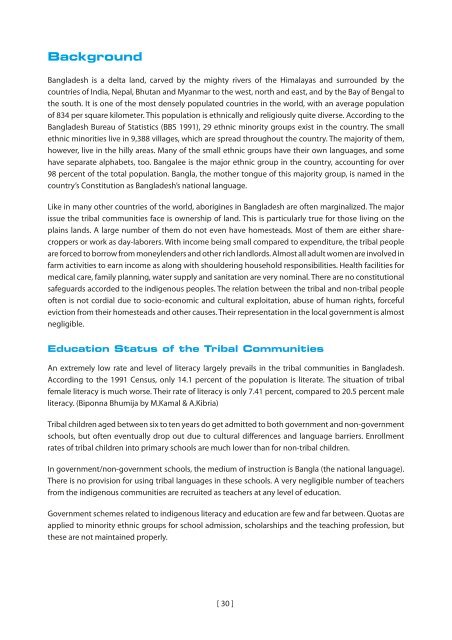Mother Tongue-based Literacy Programmes: Case Studies of Good ...
Mother Tongue-based Literacy Programmes: Case Studies of Good ...
Mother Tongue-based Literacy Programmes: Case Studies of Good ...
You also want an ePaper? Increase the reach of your titles
YUMPU automatically turns print PDFs into web optimized ePapers that Google loves.
BackgroundBangladesh is a delta land, carved by the mighty rivers <strong>of</strong> the Himalayas and surrounded by thecountries <strong>of</strong> India, Nepal, Bhutan and Myanmar to the west, north and east, and by the Bay <strong>of</strong> Bengal tothe south. It is one <strong>of</strong> the most densely populated countries in the world, with an average population<strong>of</strong> 834 per square kilometer. This population is ethnically and religiously quite diverse. According to theBangladesh Bureau <strong>of</strong> Statistics (BBS 1991), 29 ethnic minority groups exist in the country. The smallethnic minorities live in 9,388 villages, which are spread throughout the country. The majority <strong>of</strong> them,however, live in the hilly areas. Many <strong>of</strong> the small ethnic groups have their own languages, and somehave separate alphabets, too. Bangalee is the major ethnic group in the country, accounting for over98 percent <strong>of</strong> the total population. Bangla, the mother tongue <strong>of</strong> this majority group, is named in thecountry’s Constitution as Bangladesh’s national language.Like in many other countries <strong>of</strong> the world, aborigines in Bangladesh are <strong>of</strong>ten marginalized. The majorissue the tribal communities face is ownership <strong>of</strong> land. This is particularly true for those living on theplains lands. A large number <strong>of</strong> them do not even have homesteads. Most <strong>of</strong> them are either sharecroppersor work as day-laborers. With income being small compared to expenditure, the tribal peopleare forced to borrow from moneylenders and other rich landlords. Almost all adult women are involved infarm activities to earn income as along with shouldering household responsibilities. Health facilities formedical care, family planning, water supply and sanitation are very nominal. There are no constitutionalsafeguards accorded to the indigenous peoples. The relation between the tribal and non-tribal people<strong>of</strong>ten is not cordial due to socio-economic and cultural exploitation, abuse <strong>of</strong> human rights, forcefuleviction from their homesteads and other causes. Their representation in the local government is almostnegligible.Education Status <strong>of</strong> the Tribal CommunitiesAn extremely low rate and level <strong>of</strong> literacy largely prevails in the tribal communities in Bangladesh.According to the 1991 Census, only 14.1 percent <strong>of</strong> the population is literate. The situation <strong>of</strong> tribalfemale literacy is much worse. Their rate <strong>of</strong> literacy is only 7.41 percent, compared to 20.5 percent maleliteracy. (Biponna Bhumija by M.Kamal & A.Kibria)Tribal children aged between six to ten years do get admitted to both government and non-governmentschools, but <strong>of</strong>ten eventually drop out due to cultural differences and language barriers. Enrollmentrates <strong>of</strong> tribal children into primary schools are much lower than for non-tribal children.In government/non-government schools, the medium <strong>of</strong> instruction is Bangla (the national language).There is no provision for using tribal languages in these schools. A very negligible number <strong>of</strong> teachersfrom the indigenous communities are recruited as teachers at any level <strong>of</strong> education.Government schemes related to indigenous literacy and education are few and far between. Quotas areapplied to minority ethnic groups for school admission, scholarships and the teaching pr<strong>of</strong>ession, butthese are not maintained properly.[ 30 ]

















